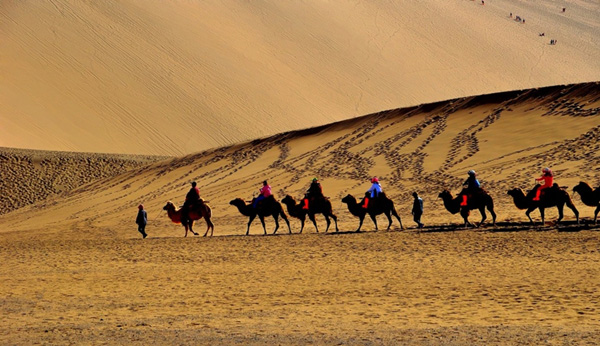Transit agreements could be key to Belt & Road success
 |
|
Tourists ride camels on the Mingsha Sand Dunes during a visit to Crescent Moon Spring on the outskirts of Dunhuang county of northwest China's Gansu province. [Photo/China Daily] |
Chinese Premier Li Keqiang's Work Report to the National People's Congress drew attention to China's efforts to stay engaged with the world economy. Such engagement is difficult at a time when resistance to trade is increasing and more and more countries are implementing inward-looking policies. The negative attitudes to trade, foreign investment and movement of people across borders makes it important to develop new strategies towards external engagement. For China, the Belt and Road (B&R) Initiative is an example of a novel strategy for deepening and widening external engagement.
The unique part of the B&R Initiative is its emphasis on creating land and sea infrastructure. Infrastructure is a perpetual requirement of all countries. Regional infrastructure and connectivity projects are relatively easy to take forward politically given the common emphasis of involved countries on infrastructure. Such projects increase trade, investment and movement of people among countries in an almost automatic fashion. Cross-country infrastructure projects serve the objective of increasing cross-border trade and are, therefore, easier ways of enhancing trade than free trade agreements, which, in many parts of the world today, are being heavily opposed.
Premier Li's Work Report emphasizes the need to continue to strengthen the B&R Initiative through consultation and collaboration. Consultation is the only way to take forward an initiative of such scale. There are substantive challenges involved in the development of the plan. For land corridors, there are important issues of transport transit agreements between various countries. While roads might cross borders, they won't be heavily used until vehicles have permits to freely offload and pick up cargo from either side. Similarly, visas that allow multiple entries for transport operators and other businesspeople across borders are needed. The European Union's success in generating high internal trade has largely been due to the ease with which vehicles and people can move back and forth between EU member countries. China will need to develop a constructive coalition of partner countries in the initiative to tackle these tricky issues. Failing this, the economic impact of the initiative might remain marginal.
The challenge of reaching multi-country agreements on transit and visas are compounded by the challenge of ensuring joint insurance of cargo being moved across borders. This is a serious problem given there may not be adequate insurance providers in many countries connected by the B&R Initiative. This is an issue that will arise not only for the movement of cargo across land, but also across the new maritime routes. However, cargo across sea might be easier to be insured since the global shipping industry has greater experience in obtaining insurance across continental shipping routes.
The Belt and Road Initiative, while being an important project for expanding regional trade, investment and connectivity, also faces the challenge of dealing with several regions and countries that are low on global economic integration. South Asia, the Middle East and Africa, which figure in the initiative, have lower economic integration with the world economy, compared with China, Europe and Southeast Asia. Countries and regions with lower global integration have more work to do in preparing themselves to integrate with the B&R Initiative. China's challenge will be to provide constructive leadership to a group of countries that are economically heterogeneous and diverse in infrastructure capacities in order to make the initiative a success.
The author is a Senior Research Fellow and Research Lead (Trade and Economic Policy) at the Institute of South Asian Studies (ISAS) at the National University of Singapore.
- Belt and Road opens new chapter for authors
- Li: Shaanxi must exploit Belt, Road
- Belt and Road opens new chapter for authors
- Russian expert says China's Belt and Road Initiative counters anti-globalization
- Chinese envoy on key achievements along Belt and Road in 2016
- Belt and Road forum will clear many doubts
- FM: Belt and Road 'belongs to world'
- Leaders from over 20 countries to attend Belt and Road Initiative forum in Beijing
- China's Belt and Road Initiative 'great enabler' of sustainable development: IPU chief




















